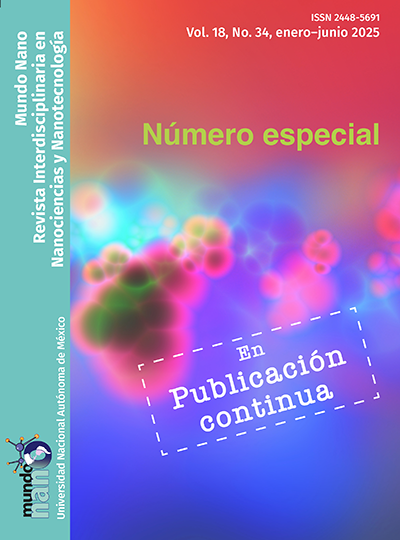Andamios impresos en 3D con poros heterogéneos como estrategia de regeneración ósea in vivo
Contenido principal del artículo
Resumen
Andamios impresos en 3D con poros heterogéneos, surge como estrategia para la regeneración de tejidos. En este estudio, se evaluó la regeneración ósea en defectos críticos de ratas Wistar, debido a la osteoconducción de andamios de poliácido-láctico (PAL), impresos en 3D con diferentes tamaños de poros; 250-300 µm en la periferia, seguido de 350-400 µm y en el centro 400-740 µm, debido a que los pequeños promueven adhesión celular, mientras que los grandes la angiogénesis. Los andamios se imprimieron en 3D con PLA, un material termoplástico, biocompatible, biorreabsorbible, aprobado por la Administración de Alimentos y Medicamentos de los Estados Unidos (FDA, por sus siglas en inglés), evaluando tamaño de poro y porosidad, in vivo, en defectos de 9 mm de diámetro en calvarias de ratas, calculando el tejido mineralizado por la radiodensidad de las unidades Hounsfield (UH) en imágenes microtomográficas a 8, 30, 60 y 90 días. Los resultados demostraron rango de poros de 200-800 µm (como el diseño), la porosidad fue del 98%, favoreciendo el flujo de nutrientes, oxígeno y eliminación de desechos. Se observó in vivo tejido radiodenso al día 30, evidentemente al 90, concordando con las UH 93.66 y 118.31, respectivamente. Los andamios 3D con poros heterogéneos, demostraron su capacidad osteoconductora en la regeneración ósea, abriendo alternativas en la bioingeniería tisular.
Descargas
Detalles del artículo

Mundo Nano. Revista Interdisciplinaria en Nanociencias y Nanotecnología, editada por la Universidad Nacional Autónoma de México, se distribuye bajo una Licencia Creative Commons Atribución-NoComercial 4.0 Internacional.
Basada en una obra en http://www.mundonano.unam.mx.
Citas
Abbasi, Naghmeh, Stephen Hamlet, Robert M. Love y Nam Trung Nguyen. (2020). Porous scaffolds for bone regeneration. Journal of Science: Advanced Materials and Devices, 5(1): 1-9. https://doi.org/10.1016/j.jsamd.2020.01.007. DOI: https://doi.org/10.1016/j.jsamd.2020.01.007
Bauermeister, Adam J., Alexander Zuriarrain y Martin I. Newman. (2016). Three-dimensional printing in plastic and reconstructive surgery. Annals of Plastic Surgery, 77(5): 569-76. https://doi.org/10.1097/SAP.0000000000000671. DOI: https://doi.org/10.1097/SAP.0000000000000671
Bružauskaitė, Ieva, Daiva Bironaitė, Edvardas Bagdonas y Eiva Bernotienė. (2016). Scaffolds and cells for tissue regeneration: different scaffold pore sizes – different cell effects. Cytotechnology, 68 (3): 355-69. https://doi.org/10.1007/s10616-015-9895-4. DOI: https://doi.org/10.1007/s10616-015-9895-4
Cai, Zhongyu, Yong Wan, Matthew L. Becker, Yun-Ze Long y David Dean. (2019). Poly(propylene fumarate)-based materials: synthesis, functionalization, properties, device fabrication and biomedical applications. Biomaterials, 208: 45-71, julio. https://doi.org/10.1016/j.biomaterials.2019.03.038. DOI: https://doi.org/10.1016/j.biomaterials.2019.03.038
Chabrand, P. (2018). Biomecánica del tejido óseo. EMC – Aparato Locomotor, 51(3): 1-8. https://doi.org/10.1016/S1286-935X(18)92752-8. DOI: https://doi.org/10.1016/S1286-935X(18)92752-8
Chung, Sangwon y Martin W. King. (2011). Design concepts and strategies for tissue engineering scaffolds. Biotechnology and Applied Biochemistry, 58(6): 423-38. https://doi.org/10.1002/bab.60. DOI: https://doi.org/10.1002/bab.60
Diao, Jingjing, Jun OuYang, Ting Deng, Xiao Liu, Yanting Feng, Naru Zhao, Chuanbin Mao y Yingjun Wang. (2018). 3D‐plotted beta‐tricalcium phosphate scaffolds with smaller pore sizes improve in vivo bone regeneration and biomechanical properties in a critical‐sized calvarial defect rat model. Advanced Healthcare Materials, 7(17). https://doi.org/10.1002/adhm.201800441. DOI: https://doi.org/10.1002/adhm.201800441
Do, Anh‐Vu, Behnoush Khorsand, Sean M. Geary y Aliasger K. Salem. (2015). 3D printing of scaffolds for tissue regeneration applications. Advanced Healthcare Materials, 4(12): 1742-62. https://doi.org/10.1002/adhm.201500168. DOI: https://doi.org/10.1002/adhm.201500168
Gaihre, Bipin, Maria D. Astudillo Potes, Xifeng Liu, Maryam Tilton, Emily Camilleri, Asghar Rezaei, Vitalii Serdiuk et al. (2024). Extrusion 3D‐printing and characterization of poly(caprolactone fumarate) for bone regeneration applications. Journal of Biomedical Materials Research Part A, 112(5): 672-84. https://doi.org/10.1002/jbm.a.37646. DOI: https://doi.org/10.1002/jbm.a.37646
Gillman, Cassidy E. y Ambalangodage C. Jayasuriya. (2021). FDA-approved bone grafts and bone graft substitute devices in bone regeneration. Materials Science and Engineering: C, 130: 112466, noviembre. https://doi.org/10.1016/j.msec.2021.112466. DOI: https://doi.org/10.1016/j.msec.2021.112466
Hidalgo, Héctor Malagón, Gabriela Wong Romo y Roberto Takeo Rivera Estolano. (2009). Stereolithography. Journal of Craniofacial Surgery, 20(5): 1473-77. https://doi.org/10.1097/SCS.0b013e3181b09a70. DOI: https://doi.org/10.1097/SCS.0b013e3181b09a70
Huang, Yu-Hui, Rosemary Seelaus, Linping Zhao, Pravin K Patel y Mimis Cohen. (2016). Virtual surgical planning and 3D printing in prosthetic orbital reconstruction with percutaneous implants: a technical case report. International Medical Case Reports Journal, 9:341-45, noviembre. https://doi.org/10.2147/IMCRJ.S118139. DOI: https://doi.org/10.2147/IMCRJ.S118139
Kantaros, Antreas. (2022). 3D printing in regenerative medicine: technologies and resources utilized. International Journal of Molecular Sciences, 23(23): 14621. https://doi.org/10.3390/ijms232314621. DOI: https://doi.org/10.3390/ijms232314621
Liu, Mengying y Yonggang Lv. (2018). Reconstructing bone with natural bone graft: a review of in vivo studies in bone defect animal model. Nanomaterials, 8(12): 999. https://doi.org/10.3390/nano8120999. DOI: https://doi.org/10.3390/nano8120999
Loh, Qiu Li y Cleo Choong. 2013. Three-dimensional scaffolds for tissue engineering applications: role of porosity and pore size. Tissue Engineering Part B: Reviews, 19(6): 485-502. https://doi.org/10.1089/ten.teb.2012.0437. DOI: https://doi.org/10.1089/ten.teb.2012.0437
Mejía Suaza, Mónica Liliana, María Elena Moncada y Claudia Patricia Ossa-Orozco. (2020). Characterization of electrospun silk fibroin scaffolds for bone tissue engineering: a review. TecnoLógicas, 23(49): 33-51. https://doi.org/10.22430/22565337.1573. DOI: https://doi.org/10.22430/22565337.1573
Pérez-Sánchez, Lucía, Misael Aaron Ortiz de la O., Patricia González-Alva, Luis Alberto Medina, David Masuoka-Ito, Marco Antonio Álvarez-Pérez y Janeth Serrano-Bello. (2021). In vivo study on bone response to 3D-printed constructs designed from microtomographic images. Journal of Materials Engineering and Performance, 30(7): 5005-12. https://doi.org/10.1007/s11665-021-05585-8. DOI: https://doi.org/10.1007/s11665-021-05585-8
Prasopthum, Aruna, Mick Cooper, Kevin M. Shakesheff y Jing Yang. (2019). Three-dimensional printed scaffolds with controlled micro-/nanoporous surface topography direct chondrogenic and osteogenic differentiation of mesenchymal stem cells. ACS Applied Materials & Interfaces, 11(21): 18896-906. https://doi.org/10.1021/acsami.9b01472. DOI: https://doi.org/10.1021/acsami.9b01472
Qin, Wen, Chenkai Li, Chun Liu, Siyu Wu, Jun Liu, Jiayi Ma, Wenyang Chen, Hongbin Zhao y Xiubo Zhao. (2022). 3D printed biocompatible graphene oxide, attapulgite, and collagen composite scaffolds for bone regeneration. Journal of Biomaterials Applications, 3 (10): 1838-51. https://doi.org/10.1177/08853282211067646. DOI: https://doi.org/10.1177/08853282211067646
Saini, P., M. Arora y M. N. V. Ravi Kumar. (2016). “Oly(lactic acid) blends in biomedical applications. Advanced Drug Delivery Reviews, 107: 47-59, diciembre. https://doi.org/10.1016/j.addr.2016.06.014. DOI: https://doi.org/10.1016/j.addr.2016.06.014
Shanbhag, Siddharth, Salwa Suliman, Samih Mohamed-Ahmed, Carina Kampleitner, Mohamed Nageeb Hassan, Patrick Heimel, Toni Dobsak, Stefan Tangl, Anne Isine Bolstad y Kamal Mustafa. (2021). Bone regeneration in rat calvarial defects using dissociated or spheroid mesenchymal stromal cells in scaffold-hydrogel constructs. Stem Cell Research & Therapy, 12(1): 575. https://doi.org/10.1186/s13287-021-02642-w. DOI: https://doi.org/10.1186/s13287-021-02642-w
Su, Xin, Ting Wang y Shu Guo. (2021). Applications of 3D printed bone tissue engineering scaffolds in the stem cell field. Regenerative Therapy, 16: 63-72, marzo. https://doi.org/10.1016/j.reth.2021.01.007. DOI: https://doi.org/10.1016/j.reth.2021.01.007
Subramaniam, S. R., M. Samykano, S. K. Selvamani, W. K. Ngui, K. Kadirgama, K. Sudhakar y M. S. Idris. (2019). 3D printing: overview of PLA progress. 020015. https://doi.org/10.1063/1.5085958. DOI: https://doi.org/10.1063/1.5085958
Sultan, Sahar y Aji P. Mathew. (2018). 3D printed scaffolds with gradient porosity based on a cellulose nanocrystal hydrogel. Nanoscale, 10(9): 4421-31. https://doi.org/10.1039/C7NR08966J. DOI: https://doi.org/10.1039/C7NR08966J
Taib, Nur-Azzah Afifah Binti, Md Rezaur Rahman, Durul Huda, Kuok King Kuok, Sinin Hamdan, Muhammad Khusairy Bin Bakri, Muhammad Rafiq Mirza Bin Julaihi y Afrasyab Khan. (2023). A review on poly lactic acid (PLA) as a biodegradable polymer. Polymer Bulletin, 80(2): 1179-1213. https://doi.org/10.1007/s00289-022-04160-y. DOI: https://doi.org/10.1007/s00289-022-04160-y
Van, Bael, S, Y.C. Chai, S. Truscello, M. Moesen, G. Kerckhofs, H. Van Oosterwyck, J.-P. Kruth y J. Schrooten. (2012). The effect of pore geometry on the in vitro biological behavior of human periosteum-derived cells seeded on selective laser-melted Ti6Al4V bone scaffolds. Acta Biomaterialia, 8(7): 2824.34. https://doi.org/10.1016/j.actbio.2012.04.001. DOI: https://doi.org/10.1016/j.actbio.2012.04.001
Wu, Jiang, Jian Zhou, Wen Zhao y Bo Gao. (2013). Evaluation of the bond strength of a low-fusing porcelain to cast Ti–24Nb–4Zr–7.9Sn aAlloy. Materials Science and Engineering: C, 33(1): 140-44. https://doi.org/10.1016/j.msec.2012.08.020. DOI: https://doi.org/10.1016/j.msec.2012.08.020
Zhang, Lei, Guojing Yang, Blake N. Johnson y Xiaofeng Jia. (2019). Three-dimensional (3D) printed scaffold and material selection for bone repair. Acta Biomaterialia, 84: 16-33, enero. https://doi.org/10.1016/j.actbio.2018.11.039. DOI: https://doi.org/10.1016/j.actbio.2018.11.039





